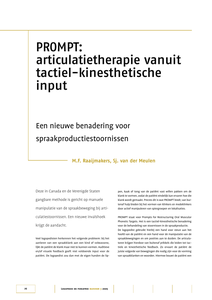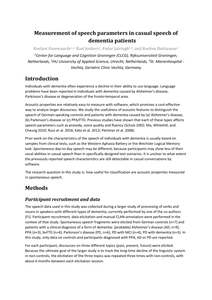Background: Collaboration between Speech and Language Therapists (SLTs) and parents is considered best practice for children with developmental disorders. However, such collaborative approach is not yet implemented in therapy for children with developmental language disorders (DLD) in the Netherlands. Improving Dutch SLTs’ collaboration with parents requires insight in factors that influence the way SLTs work with parents. Aims: To explore the specific beliefs of Dutch SLTs that influence how they collaborate with parents of children with DLD. Methods and procedures: We conducted three online focus groups with 17 SLTs using a reflection tool and fictional examples of parents to prompt their thoughts, feelings and actions on specific scenarios. Data were organised using the Theoretical Domains Framework (TDF). Outcomes and results: We identified 34 specific beliefs across nine TDF domains on how SLTs collaborate with parents of children with DLD. The results indicate that SLTs hold beliefs on how to support SLTs in collaborating with parents but also conflicting specific beliefs regarding collaborative work with parents. The latter relate to SLTs’ perspectives on their professional role and identity, their approach towards parents, and their confidence and competence in working collaboratively with parents.
DOCUMENT

Background Children with speech sound disorders (SSD) are at higher risk of communication breakdown, but the impact of having an SSD may vary from child to child. Determining the severity of SSD helps speech-language therapists (SLTs) to recognise the extent of the problem and to identify and prioritise children who require intervention. Aims This study aimed to identify severity factors for SSD in order to develop a multifactorial Speech Sound Disorder Severity Construct (SSDSC) using SLTs’ views and the International Classification of Functioning, Disability and Health (ICF). Method In an explorative five-staged qualitative study, the research question was answered: ‘How do SLTs determine the severity of SSD in children?’. A total of 91 SLTs from The Netherlands participated in data collection and analysis. The iterative process included three different qualitative research methodologies (thematic analysis [TA], constructivist grounded theory [CGT] and content analysis [CA]) to ensure validation of the results by means of method triangulation. Results SLTs considered nine themes: intelligibility, speech accuracy, persistence, the child's perception, impact, communicative participation, concomitant factors, professional point of view, and environmental factors. The themes were summarised in three main severity factors: (I) Speech accuracy, (II) The child's perception of the impact of their speech, and (III) Intelligibility in communication. Other severity factors were concomitant factors and impact. Expertise and support were identified as facilitators or barriers that may worsen or relieve the severity of SSD. Conclusions This study highlights the need for SLTs to rethink how they think about severity as a simplistic construct reflecting only speech accuracy. It is recommended that a broader holistic approach to measuring severity is adopted.
LINK
Spontaneous speech is an important source of information for aphasia research. It is essential to collect the right amount of data: enough for distinctions in the data to become meaningful, but not so much that the data collection becomes too expensive or places an undue burden on participants. The latter issue is an ethical consideration when working with participants that find speaking difficult, such as speakers with aphasia. So, how much speech data is enough to draw meaningful conclusions? How does the uncertainty around the estimation of model parameters in a predictive model vary as a function of the length of texts used for training?
DOCUMENT

BACKGROUND: Atypical speech and language development is one of the most common developmental difficulties in young children. However, which clinical signs characterize atypical speech-language development at what age is not clear.AIM: To achieve a national and valid consensus on clinical signs and red flags (i.e. most urgent clinical signs) for atypical speech-language development in children from 1 to 6 years of age.METHODS & PROCEDURES: A two-round Delphi study in the Netherlands with a national expert panel (n = 24) of speech and language therapists was conducted. The panel members responded to web-based questionnaires addressing clinical signs. Consensus was defined as ≥ 70% of the experts agreeing on an issue.OUTCOMES & RESULTS: The first round resulted in a list of 161 characteristics of atypical speech and language development. The second round led to agreement on 124 clinical signs and 34 red flags.CONCLUSIONS & IMPLICATIONS: Dutch national consensus concerns 17-23 clinical signs per age year for the description of an atypical speech-language development in young children and three to 10 characteristics per age year being red flags for atypical speech-language development. This consensus contributes to early identification and diagnosis of children with atypical speech-language development, awareness and research.
DOCUMENT
PROMPT is a tactile-kinesthetic approach for assessment and treatment of speech production disorders. PROMPT uses tactile-kinethetic cues to facilitate motor speech behaviors. Therapy is structured from basic motor speech patterns with much tactile-lkinesthetic cueing, towards complex motor speech activities with less cueing. This article describes the purpose and contents of PROMPT assessment and therapy.
DOCUMENT

Snel nadat duidelijk werd dat Barack Obama de Amerikaanse presidentsverkiezingen gewonnen had, hield hij in Chicago zijn overwinningstoespraak. Was dit de historische toespraak waar Amerika op zat te wachten? Hoe goed was de speech eigenlijk? Ik zal hier een korte analyse presenteren van Obama's victory speech om aan te tonen dat deze retorisch goed in elkaar steekt.
DOCUMENT

There is a need to assess communication in daily life situations for people with speech and language disorders. Although language proficiency and communication in daily life are correlated, their relationship is far from linear or straightforward. This paper aims to demonstrate the usefulness of the construct of communicative participation by unravelling the relationship and overlap between participation and communication. We explored the relationship between communication, participation, and communicative participation by reviewing common definitions mentioned in the literature. Next, we evaluated to what extent communication plays a role in each of the World Health Organization’s International Classification of Functioning (ICF) “Activity and Participation” chapters by counting how many items in each chapter should be considered for describing communicative participation.
MULTIFILE
From the article: "Individuals with dementia often experience a decline in their ability to use language. Language problems have been reported in individuals with dementia caused by Alzheimer’s disease, Parkinson’s disease or degeneration of the fronto-temporal area. Acoustic properties are relatively easy to measure with software, which promises a cost-effective way to analyze larger discourses. We study the usefulness of acoustic features to distinguish the speech of German-speaking controls and patients with dementia caused by (a) Alzheimer’s disease, (b) Parkinson’s disease or (c) PPA/FTD. Previous studies have shown that each of these types affects speech parameters such as prosody, voice quality and fluency (Schulz 2002; Ma, Whitehill, and Cheung 2010; Rusz et al. 2016; Kato et al. 2013; Peintner et al. 2008). Prior work on the characteristics of the speech of individuals with dementia is usually based on samples from clinical tests, such as the Western Aphasia Battery or the Wechsler Logical Memory task. Spontaneous day-to-day speech may be different, because participants may show less of their vocal abilities in casual speech than in specifically designed test scenarios. It is unclear to what extent the previously reported speech characteristics are still detectable in casual conversations by software. The research question in this study is: how useful for classification are acoustic properties measured in spontaneous speech."
MULTIFILE

ABSTRACT Purpose: This short paper describes the dashboard design process for online hate speech monitoring for multiple languages and platforms. Methodology/approach: A case study approach was adopted in which the authors followed a research & development project for a multilingual and multiplatform online dashboard monitoring online hate speech. The case under study is the project for the European Observatory of Online Hate (EOOH). Results: We outline the process taken for design and prototype development for which a design thinking approach was followed, including multiple potential user groups of the dashboard. The paper presents this process's outcome and the dashboard's initial use. The identified issues, such as obfuscation of the context or identity of user accounts of social media posts limiting the dashboard's usability while providing a trade-off in privacy protection, may contribute to the discourse on privacy and data protection in (big data) social media analysis for practitioners. Research limitations/implications: The results are from a single case study. Still, they may be relevant for other online hate speech detection and monitoring projects involving big data analysis and human annotation. Practical implications: The study emphasises the need to involve diverse user groups and a multidisciplinary team in developing a dashboard for online hate speech. The context in which potential online hate is disseminated and the network of accounts distributing or interacting with that hate speech seems relevant for analysis by a part of the user groups of the dashboard. International Information Management Association
LINK